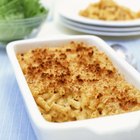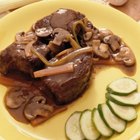
A cream sauce such as Alfredo, béarnaise or hollandaise should have some richness, but that quality is missing if the sauce isn’t thick enough. The most important step in thickening a sauce is reduction -- the process of simmering liquid to cook the moisture out. If reduction alone is not enough, adding a thickener improves the consistency. Add 1 level tablespoon of a thickener and then reduce the sauce for three to five minutes before deciding if you need to add more. Thickening agents need to cook for several minutes to reach their potential.
Flour Power
In most kitchens, flour is the most readily available thickener. Instant flour is all-purpose flour that’s been milled longer to create extra-fine particles and reduce protein. It dissolves quickly, forming few if any lumps. Regular all-purpose flour is more likely to clump, but both products are effective as long as you whisk them into the sauce thoroughly. Simmer the sauce for several minutes to eliminate the raw flour taste.
Kneaded Butter
Kneaded butter, or “beurre manié,” is made of equal parts cold butter and flour. Use real butter; margarine will not work. Mash the ingredients together in a bowl until the mixture has the consistency of a dough or thick paste. Measure a level tablespoon of the kneaded butter and then roll the paste into a ball with your hands. Stir the sauce frequently after you drop a ball of kneaded butter into the sauce. Once it reaches the desired consistency, remove the pan from the heat to prevent the sauce from developing a starchy taste.
Rich, Flavorful Roux
Roux, the most common thickener for cream sauces, is a cooked mixture of fat and flour. Butter and meat drippings, such as rendered bacon fat, are suitable for roux, though butter is use more often. Heat the fat in a pan over low heat and add an equal amount of flour. Cook the roux for five to 15 minutes, whisking constantly. It should become white or golden; if it starts to brown, reduce the heat. Whisk constantly each time you add a tablespoonful of roux to simmering sauce. As the sauce reduces, stir frequently to prevent clumps. Once it reaches the desired consistency, simmer it on low heat for several minutes to eliminate the roux’s raw flour taste.
Cornstarch: Slurry to Sidestep Clumps
Cornstarch has a mild taste and adds a slight sheen to sauce. If you add cornstarch directly to hot liquid, it clumps. To avoid this problem, whisk equal parts cornstarch and cold water or milk in a bowl to make a slurry, which blends into hot sauce without clumping. Sauces that contain cornstarch are prone to thinning if you stir them often. Use cornstarch in a sauce that you plan to serve as soon as it finishes cooking, because it may become gelatinous after cooling to room temperature.
The Incredible, Thickening Egg
Egg yolks are the most effective thickeners for sauces that already contain egg, such as hollandaise sauce. Yolks can curdle in hot liquid, but gently warming the yolk separately -- which is called tempering -- prepares it for the sauce. To temper a yolk, whisk it with a splash of cream or milk, which will help buffer the delicate yolk from the heat. Whisk spoonfuls of sauce into the yolk 1 tablespoon at a time until you have about 1/4 to 1/3 cup of the mixture. Add the egg yolk mixture to the sauce, and simmer over low heat. Even tempered yolks can curdle, so keep the temperature low.
Related Articles

Why Does a Sauce Curdle?

How to Make French Sauce With Roux of ...

What Is Ratio for Cornstarch & Water to ...

Do You Use Flour or Corn Starch to ...

What Else Could You Use Besides Cream ...

Why Does Milk Curdle When it Is Mixed ...
What Can I Substitute for Cornstarch?

Cooking Yogurt Without Curdling It

Can I Use Baking Powder to Thicken ...

How to Get Half & Half to Thicken
Can You Substitute Cornstarch for Flour?

Why Does Milk Curdle When Baking a ...

How to Make Fish Taco Sauce
How Many Calories Are in Peanut Sauce?
How to Scald Milk for Cooking

How to Use Leftover Marinade in Gravy

Cooking Yogurt Without Curdling It

How to Fix Mayo With Broken Emulsion

How to Substitute Cornstarch for ...

How Much Flour to Thicken a Sauce?
References
- Joy of Cooking; Irma Rombauer and Marion Rombauer-Becker
- Fine Cooking: Instant Flour
- Fine Cooking: Thickeners
Writer Bio
Lamar Grey has been writing about cooking and food culture since 2010. He has ghostwritten eight cookbooks. Grey entered the culinary industry in 2003 as a prep cook in a full-service restaurant. He subsequently served as a baker and head cook on three award-winning kitchen staffs.
Photo Credits
Adam Gault/Digital Vision/Getty Images